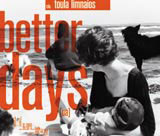True blue
Adrian Shaughnessy celebrates the uncompromising work of German graphics group Cyan.

German graphics consultancy Cyan was one of the hits of the recent GraficEurope conference in Berlin. Its striking and emotive work caused seasoned conference delegates to drool in admiration. The group’s modest and heartfelt presentation provided a welcome alternative to some of the showier, ‘look-at-me’ performances by more famous names.
Based in Berlin, Cyan was founded in 1992 by Daniela Haufe and Detlef Fiedler. They first met and worked together at Grappa, the respected East Berlin design studio. ‘Within Grappa, the two of us worked together on most projects and became a close team,’ says Haufe. ‘Out of this working relationship the idea emerged to leave Grappa and form Cyan, where we could work together more intensively.’
Twelve years later, Cyan’s staff is now four-strong, and produces graphic design and multimedia almost exclusively for clients in the cultural sector. Haufe and Fiedler are quick to point out that they work ‘as a team on each project, and it varies from job to job who is responsible for what’.
Cyan’s approach to graphic design is uncompromising. Listening to Haufe and Fiedler talk about their working practices, you sense that once they’ve made up their mind about something, they won’t be shifted. Yet they seem to have none of the hectoring egotism that so often accompanies ‘uncompromising’ designers. In fact, what distinguishes the group’s work is its hybrid originality and its meticulous detail – work that clearly couldn’t be produced without trusting, admiring and supportive clients. Cyan’s clients include: the Jewish Museum, Berlin, the British Council in Germany, Berlin National Gallery, Bauhaus Dessau and Dance Company Toula Limnaios.
Over and above the sheer graphic inventiveness of its work, perhaps Cyan’s finest quality is its unrelenting resourcefulness. It is the studio’s single-minded determination to create vibrant graphic statements despite low-to-no budgets that sets Cyan apart from the pack, and made so many GraficEurope delegates wonder why they hadn’t heard of the group before. ‘We work only in the cultural sector because that is a field where we are interested in the content,’ Haufe explains. ‘And because there is never enough money in the cultural sector, we simply have to deal with low-budget work.’
The work is hard to define. It’s not Modernism, although it has Modernist accents. It’s not trendy, digital noodling either; nor is it particularly German. Other than the need to cope with limited resources, it seems not to be driven by any stylistic or philosophical stance. ‘We don’t have a philosophy,’ Haufe explains. ‘We simply do our work as best as we can. We are fascinated by the early 20th century avant- garde, but we are also interested in art, music, architecture and film. You can’t really draw it down to a single dominant influence.’
In interviews the pair have been dismissive of contemporary commercial design and modern clients’ obsession with the quick fix. Their intention is to produce work which, to use their phrase, ‘cannot be exhausted by being looked at briefly once’. Surprisingly, in view of its rejection of short-term solutions, the group has recently designed a poster for football body Fifa – announcing Germany’s hosting of the 2006 World Cup. Was this a move towards working in more mainstream or corporate sectors? ‘Unfortunately, we have never been offered an interesting job within this field,’ Haufe states. ‘We aren’t really sports fans, but we think that sport is a good alternative to war. So for this reason we also designed the corporate identity for the German application for the Olympic Games.’
As well as its quirky, yet fastidiously executed print design, Cyan is also particularly well-known for its vividly expressive moving image work, which is as unconventional and unpredictable as its print work. The group showed an elegant photographic-based film made for Dance Company Toula Limnaios which contrasted with more adventurous, retina-stretching, Op-Art animations made for a variety of what the group calls ‘independent cultural clients’. At a time when there is a great deal of talk about graphic designers becoming the next generation of film-makers (some say this process is already underway), Cyan’s work is evidence of the fact that it is possible to make compelling mini-films without recourse to conventional animation and film-making techniques. Its films are graphic design in motion. ‘We are not film-makers,’ says Haufe, ‘but graphic designers who are interested in having the factor of “time” as an additional design tool.’
As contemporary graphic design is slowly sucked into the maw of branding, Cyan appears like a little knot of resistance. Neither trendy nor classical, its work reminds us that graphic design can have its own inherent value, and that it needn’t always be dancing to the tune of brand guidelines and corporate conformity.
-
Post a comment



